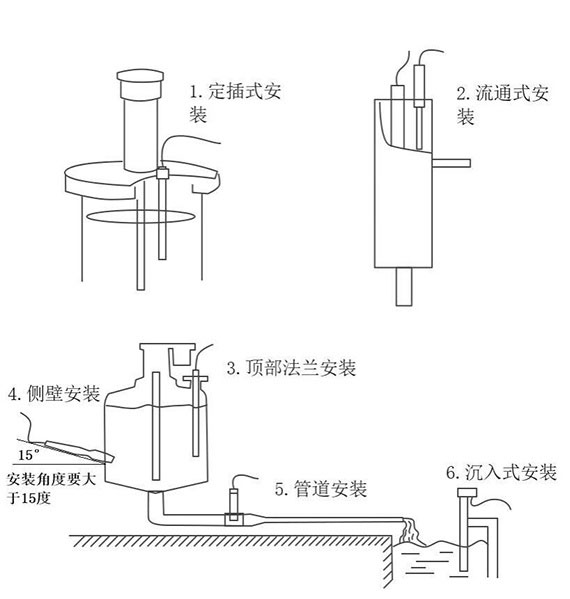Tianyi Sensor IOT Technology Co., Ltd
Sales Manager:Ms. Emily Wang
Cel,Whatsapp,Wechat:+86 15898932201
Email:info@fengtutec.com
Add:No. 155 Optoelectronic Industry Accelerator, Gaoxin District, Weifang, Shandong, China

Sales Manager:Ms. Emily Wang
Cel,Whatsapp,Wechat:+86 15898932201
Email:info@fengtutec.com
Add:No. 155 Optoelectronic Industry Accelerator, Gaoxin District, Weifang, Shandong, China

Model:FT-S7
Brand:tianyi
one.Water conductivity sensor application environment description
water conductivity sensor is a device used to measure the conductivity of a solution. Conductivity is used to measure the purity of water or the concentration of ionized chemicals in water.It is used for environmental water quality detection and various high/low ionic strength water sample testing, which can meet the requirements of most industrial/environmental applications for online conductivity measurement.
Signal output: RS485 (MODBUS-RTU).
Internal signal isolation technology has strong interference.
Good reproducibility, thermal stability, low drift, small size, fast response speed
Easy to install, simple, 3/4NPT pipe threads, easy to sink-in installation or install in pipes and tanks
Stable performance and long service life
IP68 waterproof standard
24*1.2 18*1.5*2 28*2 2
two.Water conductivity sensor technical performance and specifications
1.Water conductivity sensor technical parameters
| Measurement principle | Contact electrode method |
| Signal method | RS485 (MODBUS-RTU) |
| Measurement range | 0~10000uS/cm |
| Measure resolution | 1 |
| Measurement accuracy | ±1.5%; ±0.1°C |
| Response time | About 30s (98% static liquid) |
| Housing material | ABS and 316L stainless steel |
| Temperature compensation | Automatic temperature compensation (M1820Z) |
| Cable length | Standard 5 meters |
| Power supply voltage | 12-24VDC (0.4W@12V) |
| Measurement environment | Temperature 0~50℃ (no freezing), <0.2MPa |
| Waterproof grade | IP68 |
| Installation method | Immersive mounting, NPT3/4 thread |
2.Water conductivity sensor size diagram

The sensor connector is M12 aviation plug connector 5-core mother seat
three.Water conductivity sensor installation and electrical connection
1.Water conductivity sensor installation

Note: The sensor cannot be installed inverted or horizontally when installed, and should be installed at least 15 degrees above the angle of inclination.
2.Water conductivity sensor electrical installation
The cable is a 5-core shielded wire, line sequence definition: brown-power cord (12~24VDC)
Black-ground (GND)
Blue-485A Green-485B
Yellow - 4-20mA current output (can be suspended if not used)
Before powering on, carefully check the wiring sequence to avoid unnecessary losses caused by wiring errors.
Four.Water conductivity sensor maintenance and maintenance
1.Use and maintain
Conventional electrodes require periodic cleaning and calibration, and the maintenance cycle is determined by the customer according to their working conditions.Conventional electrode cleaning methods: Use a soft brush to remove attachments (be careful to avoid scratching the electrode surface), then clean with distilled water, and then perform calibration operations.
As a densely - populated public place, the air quality in scenic spots directly affects the tourist experience and ecological value. The negative oxygen ion concentration, as a core indicator for measuring air quality, has made its monitoring system a standard configuration in the construction of sm...
The Eleven - element Photovoltaic weather station is a meteorological monitoring device used in the field of distributed photovoltaic power generation, capable of real - time monitoring of multiple meteorological elements:Scheme 1: Wind speed + Wind direction + Average wind speed + Temperature + Hum...
Meteorology and soil moisture are two fundamental elements in agriculture. Meteorology determines the "timing" of agriculture, while soil moisture reflects the "favorable geographical conditions". Together, they form the environmental framework for crop growth.The dynamic changes...
Ultrasonic resonance anemometry is a commonly used meteorological observation technology. Its principle is to utilize the propagation characteristics of ultrasonic waves in the air to measure wind speed and wind direction. When sound waves propagate in the air, their speed will be affected by the wi...